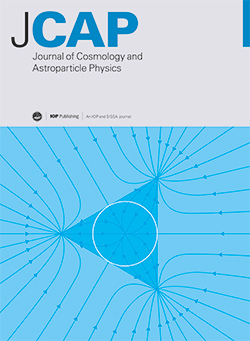用理论误差似然减轻非线性星系偏差
IF 5.3
2区 物理与天体物理
Q1 ASTRONOMY & ASTROPHYSICS
Journal of Cosmology and Astroparticle Physics
Pub Date : 2025-04-23
DOI:10.1088/1475-7516/2025/04/070
引用次数: 0
摘要
第四阶段的星系调查将在高信噪比的小宇宙尺度上测量相关性。从小尺度中提取信息的主要挑战之一是设计准确的模型,以及描述与任何给定模型相关的理论不确定性。在这项工作中,我们探讨了在光度2×2-point分析的背景下减轻非线性星系偏差引起的理论不确定性。我们考虑线性星系偏差作为基准模型,并推导了忽略高阶偏差对协方差矩阵的贡献。我们利用基于模拟的关系,将高阶参数与线性偏差联系起来,构建了星系聚类和星系-星系透镜理论误差的协方差矩阵。为了测试此缓解模型,我们基于两组模拟数据向量将修改后的似然应用于2×2-point分析:(1)由偏差参数之间相同关系构建的模拟数据向量,以及(2)基于AbacusSummit模拟套件的数据向量。然后,我们比较了理论误差方法与常用的尺度削减方法的性能。我们发现,就精度和准确度而言,大多数理论误差配置产生的结果与尺度削减相当,并且在某些情况下,特别是对于第一个数据集,它们会产生明显更强的宇宙学参数界限。这些结果与理论误差分析中的最大尺度kmax无关。我们注意到理论误差方法的相对性能主要取决于协方差矩阵对角线的选择。线性偏置加上理论误差无法恢复无偏宇宙学的情况主要出现在第二个数据集上,这与理论误差的gg-gκ协方差建模不充分有关。这种形式的交叉探针协方差在以前的工作中没有被考虑过。我们还强调了构造对理论误差的非对角线相关性的敏感性。鉴于该方法消除了kmax选择的模糊性,并且有可能获得比通常的尺度切割更高的精度,我们认为该方法有望在即将到来的光度星系调查中分析LSS。本文章由计算机程序翻译,如有差异,请以英文原文为准。
Mitigation of nonlinear galaxy bias with a theoretical-error likelihood
Stage-IV galaxy surveys will measure correlations at small cosmological scales with high signal-to-noise ratio. One of the main challenges of extracting information from small scales is devising accurate models, as well as characterizing the theoretical uncertainties associated with any given model. In this work, we explore the mitigation of theoretical uncertainty due to nonlinear galaxy bias in the context of photometric 2×2-point analyses. We consider linear galaxy bias as the fiducial model and derive the contribution to the covariance matrix induced by neglected higher-order bias. We construct a covariance matrix for the theoretical error in galaxy clustering and galaxy-galaxy lensing using simulation-based relations that connect higher-order parameters to linear bias. To test this mitigation model, we apply the modified likelihood to 2×2-point analyses based on two sets of mock data vectors: (1) simulated data vectors, constructed from those same relations between bias parameters, and (2) data vectors based on the AbacusSummit simulation suite. We then compare the performance of the theoretical-error approach to the commonly employed scale cuts methodology. We find most theoretical-error configurations yield results equivalent to the scale cuts in terms of precision and accuracy, and in some cases, especially with the first data set, they produce significantly stronger bounds on cosmological parameters. These results are independent of the maximum scale kmax in the analysis with theoretical error. We notice the relative performance of the theoretical-error approach depends mostly on the choice of the covariance-matrix diagonal. The scenarios where linear bias supplemented by theoretical error is unable to recover unbiased cosmology, which are mainly observed with the second data set, are connected to inadequate modeling of the gg-gκ covariance of theoretical error. This form of cross-probe covariance has not been considered in previous works. We additionally highlight a sensitivity of the construction to off-diagonal correlations of theoretical error. In view of its removing the ambiguity in the choice of kmax, as well as the possibility of attaining higher precision than the usual scale cuts, we consider this method to be promising for analyses of LSS in upcoming photometric galaxy surveys.
求助全文
通过发布文献求助,成功后即可免费获取论文全文。
去求助
来源期刊

Journal of Cosmology and Astroparticle Physics
地学天文-天文与天体物理
CiteScore
10.20
自引率
23.40%
发文量
632
审稿时长
1 months
期刊介绍:
Journal of Cosmology and Astroparticle Physics (JCAP) encompasses theoretical, observational and experimental areas as well as computation and simulation. The journal covers the latest developments in the theory of all fundamental interactions and their cosmological implications (e.g. M-theory and cosmology, brane cosmology). JCAP''s coverage also includes topics such as formation, dynamics and clustering of galaxies, pre-galactic star formation, x-ray astronomy, radio astronomy, gravitational lensing, active galactic nuclei, intergalactic and interstellar matter.
 求助内容:
求助内容: 应助结果提醒方式:
应助结果提醒方式:


